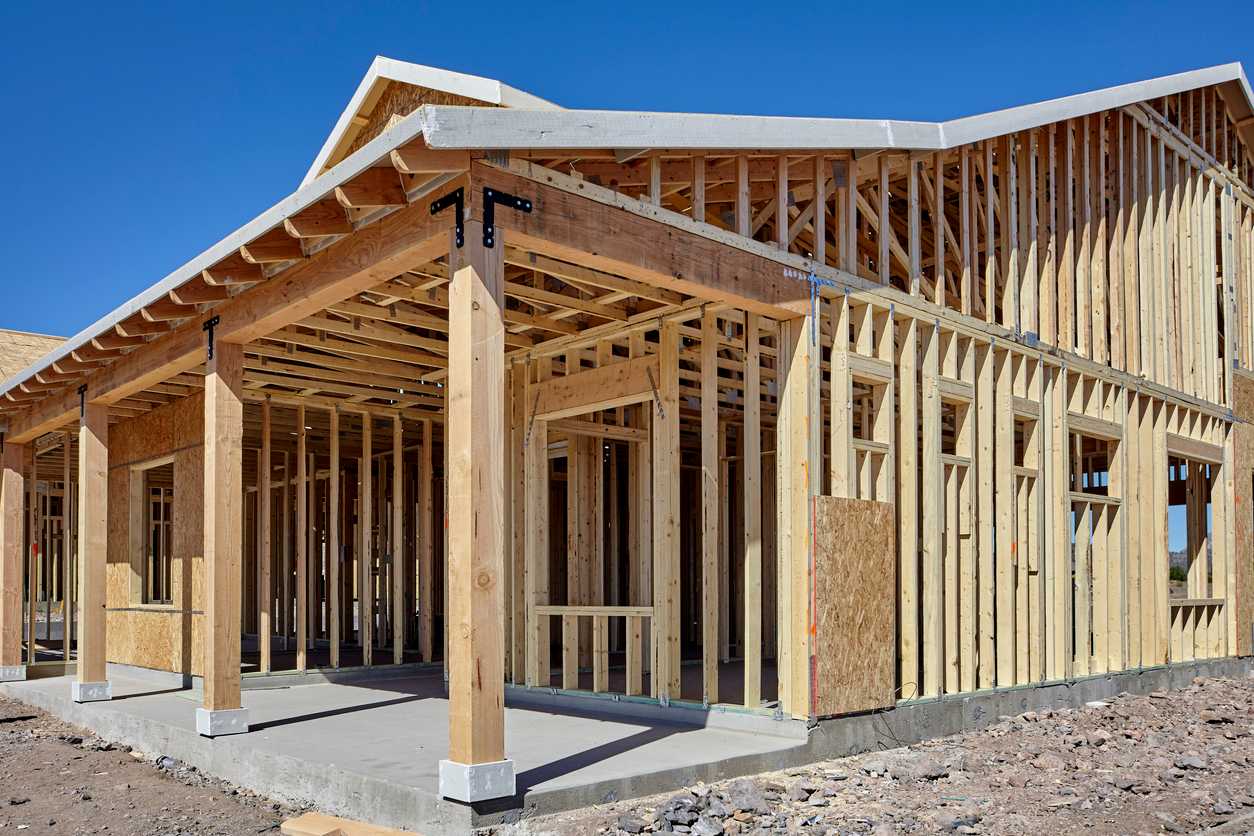Home>diy>Building & Construction>What Is Interest Reserve In A Construction Loan


Building & Construction
What Is Interest Reserve In A Construction Loan
Modified: January 24, 2024
Learn about interest reserve in a construction loan and how it impacts building construction. Discover how this financial tool can help fund ongoing construction costs.
(Many of the links in this article redirect to a specific reviewed product. Your purchase of these products through affiliate links helps to generate commission for Storables.com, at no extra cost. Learn more)
Introduction
Welcome to the world of construction loans, where financing projects can be complex and require careful planning. Among the various components involved in construction financing, the concept of an interest reserve plays a crucial role. In this article, we will explore what interest reserve is and its significance in a construction loan.
Before diving into the details, let us first understand the basic concept of a construction loan. Simply put, it is a short-term financing option specifically designed for construction projects. Unlike traditional mortgages, which are based on the completed value of a property, construction loans disburse funds in stages to cover the cost of construction as it progresses.
Now that we have a general idea of construction loans, let’s delve into the concept of an interest reserve. An interest reserve is a predetermined amount of money set aside from the loan proceeds to cover the interest payments during the construction phase of a project. It acts as a safety net, ensuring that interest payments are made promptly and without adding additional financial burden to the borrower.
The purpose of the interest reserve is twofold. First and foremost, it provides financial security to the construction lender. Since construction loans are considered riskier due to the ongoing nature of the project, having an interest reserve ensures that the lender will receive interest payments regularly and on time. This mitigates the risk of default and protects the lender’s investment.
Secondly, an interest reserve benefits the borrower by reducing the immediate cash flow burden during the construction phase. Typically, during this phase, borrowers do not have income from the property yet, and covering the interest payments out of pocket can be challenging. The interest reserve allows the borrower to focus on completing the construction without worrying about the ongoing financial obligations.
So, how does an interest reserve work? When a construction loan is approved, a specific amount is allocated as the interest reserve. This amount is typically based on the estimated interest payments for the duration of the construction phase. The interest reserve is then held in an account, separate from the construction loan funds, and is used solely for making interest payments.
Calculating the interest reserve involves determining the estimated interest rate, the loan amount, and the anticipated construction period. The lender uses these factors to project the total interest payments over the construction period and sets the interest reserve accordingly. It is important for both the lender and the borrower to agree on the calculations to ensure transparency and avoid any disputes.
The interest reserve plays a critical role in construction loans, and its importance cannot be overstated. It provides stability to the lender, ensuring that the interest payments are met promptly. For borrowers, it offers peace of mind by alleviating the immediate financial burden and allowing them to focus on completing the project.
Key Takeaways:
- The interest reserve in construction loans provides financial security for lenders and relieves cash flow burdens for borrowers during the construction phase, ensuring a smooth and successful financing process.
- Accurate calculation and effective management of the interest reserve are crucial in mitigating potential challenges, such as insufficient allocation and construction delays, to achieve the desired outcomes in construction financing.
Definition of Interest Reserve
When it comes to construction loans, the term “interest reserve” refers to a designated amount of money that is set aside from the loan proceeds specifically for covering the interest payments during the construction phase of a project. It acts as a buffer to ensure the timely payment of interest without placing an additional financial burden on the borrower.
Think of the interest reserve as a safety net. It is commonly used in construction financing to protect both the lender and the borrower. By allocating a portion of the loan funds for interest payments, the lender can ensure a steady stream of income throughout the construction process. This mitigates the risk of default and safeguards their investment.
For borrowers, the interest reserve offers significant benefits. During the construction phase of a project, it is common for borrowers to face financial strain as they balance the costs of construction without generating income from the property. The interest reserve provides relief by covering the interest payments, giving borrowers the breathing room they need to complete the project without worrying about immediate cash flow obligations.
It is important to note that the interest reserve is distinct from the actual loan funds. It is held separately in an account that is solely dedicated to making interest payments. This separation ensures transparency and prevents any confusion between the loan funds and the interest reserve.
The amount of the interest reserve is determined based on several factors. These include the estimated interest rate, the loan amount, and the anticipated duration of the construction phase. By considering these variables, lenders can calculate the projected interest payments and allocate an appropriate amount to the interest reserve.
The interest reserve is disbursed gradually throughout the construction period, with interest payments being made on a regular basis. As construction progresses and the property nears completion, the borrower can shift from relying on the interest reserve to generating income from the property. This transition allows for a smooth transition to the permanent financing phase.
Overall, the interest reserve is an essential component of construction loans. It provides financial security to lenders and relieves cash flow burdens on borrowers during the construction phase. By separating the interest payments from the loan funds and allocating a specific amount for this purpose, construction financing becomes more manageable and less financially demanding for both parties involved.
Purpose of Interest Reserve in a Construction Loan
The interest reserve in a construction loan serves several important purposes that benefit both lenders and borrowers. Understanding these purposes is crucial for ensuring smooth and effective construction financing. Let’s explore the main reasons behind the inclusion of an interest reserve in construction loans.
1. Financial Security for the Lender:
The primary purpose of the interest reserve is to provide financial security to the construction lender. Construction loans are considered riskier than traditional mortgages due to the ongoing nature of the project. By setting aside a specific amount for interest payments, the lender ensures a consistent cash flow stream throughout the construction phase. This minimizes the risk of default and protects the lender’s investment.
2. Relief for the Borrower’s Cash Flow:
During the construction phase, borrowers typically face the challenge of managing the costs of construction without generating income from the property. The interest reserve alleviates this burden by covering the interest payments, allowing the borrower to focus on completing the project without adding additional financial strain. This relief in cash flow helps ensure the successful completion of the construction, paving the way for future income from the property.
3. Stability and Smooth Construction Process:
An interest reserve contributes to a more stable construction process. By having a dedicated pool of funds specifically for interest payments, borrowers can plan their expenses and make payments regularly. This stability eliminates the risk of late or missed payments, maintaining a healthy relationship between the borrower and the lender throughout the construction phase.
4. Building Trust and Credibility:
By incorporating an interest reserve into the construction loan agreement, lenders demonstrate their commitment to the project and the borrower. This gesture builds trust and credibility between the parties involved. Borrowers perceive lenders as partners invested in the success of the project, fostering a positive and cooperative working relationship.
5. Transitional Support:
As the construction nears completion, the interest reserve helps bridge the gap between the construction phase and the permanent financing phase. As the borrower transitions from relying on the interest reserve to generating income from the property, the interest reserve ensures a smooth financial transition without any interruption in the payment of interest.
6. Risk Mitigation:
Construction loans inherently carry a higher level of risk compared to traditional mortgages. The interest reserve acts as a risk mitigation tool for lenders by ensuring timely interest payments. This reduces the potential for default and safeguards the lender’s investment in the construction project.
Overall, the purpose of the interest reserve in a construction loan is to provide financial stability, alleviate cash flow burdens, and mitigate risks for both lenders and borrowers. By addressing these purposes, an interest reserve facilitates a smooth and successful construction financing process.
How Interest Reserve Works
Understanding how the interest reserve works is essential for both lenders and borrowers involved in construction loans. The interest reserve operates as a separate component within the overall loan structure, serving a specific purpose during the construction phase. Let’s explore how the interest reserve works in practice.
When a construction loan is approved, a predetermined amount is allocated as the interest reserve. This amount is calculated based on the estimated interest payments for the anticipated duration of the construction phase. It is important for both the lender and the borrower to agree upon the calculations and ensure transparency.
The interest reserve is typically held in a separate account, distinct from the construction loan funds. This separation ensures that the funds are solely dedicated to making interest payments. It provides clarity and transparency, reducing the risk of funds being used improperly or for purposes other than intended.
As construction progresses, the interest reserve is disbursed gradually to cover the ongoing interest payments. These payments are typically made on a regular basis, such as monthly or quarterly, depending on the agreed-upon terms of the loan. The disbursement of the interest reserve ensures that the interest obligations are met promptly.
As the construction nears completion, the borrower may start generating income from the property. At this stage, the reliance on the interest reserve may reduce as the borrower begins using their own funds to cover the interest payments. The transition from relying on the interest reserve to generating income from the property signifies the nearing end of the construction phase.
It is important to note that the interest reserve is not a bottomless source of funds. It is a predetermined amount that is carefully calculated based on the projected interest payments. Once the interest reserve is depleted, the borrower becomes responsible for making the interest payments using their own funds or transitioning to permanent financing options.
The interest reserve operates as a safeguard for both lenders and borrowers. For lenders, it ensures a consistent and timely stream of interest payments, reducing the risk of default and protecting their investment. For borrowers, it provides relief by covering the interest payments during the cash-intensive construction phase, allowing them to focus on completing the project without the immediate financial burden.
In summary, the interest reserve works by allocating a specific amount from the loan funds for covering interest payments during the construction phase. It is held separately and disbursed gradually to ensure a steady flow of interest payments. The interest reserve serves as a protective mechanism for lenders and a relief for borrowers, contributing to a smooth and successful construction loan process.
Calculating the Interest Reserve
Calculating the interest reserve in a construction loan involves a careful analysis of several factors, including the loan amount, estimated interest rate, and anticipated construction period. Proper calculation is crucial to ensure that the allocated interest reserve is sufficient to cover the interest payments throughout the construction phase. Let’s explore how the interest reserve is calculated.
The first step in calculating the interest reserve is determining the loan amount. This is the total amount of funds that the borrower is borrowing from the lender to finance the construction project. The loan amount serves as the basis for calculating the interest payments.
The next factor to consider is the estimated interest rate. This is the interest rate that the borrower will be charged on the construction loan. The interest rate is typically provided by the lender and may be fixed or variable, depending on the terms of the loan agreement. It is important to use an accurate estimated interest rate to ensure accurate calculations.
Once the loan amount and estimated interest rate are determined, the anticipated construction period must be estimated. This refers to the length of time it is expected to take to complete the construction project. This period may vary depending on the complexity and scope of the project. Typically, the construction period is provided by the borrower and should be as realistic as possible.
With these factors in mind, the interest reserve can be calculated. The calculation involves multiplying the loan amount by the estimated interest rate and then multiplying that figure by the anticipated construction period. This calculation gives an estimate of the total interest that will be accrued during the construction phase.
For example, let’s say the loan amount is $500,000 and the estimated interest rate is 5%. If the anticipated construction period is 12 months, the interest reserve calculation would be as follows:
Interest Reserve = Loan Amount * Interest Rate * Construction Period
Interest Reserve = $500,000 * 0.05 * 12
Interest Reserve = $300,000
In this example, the calculated interest reserve is $300,000. This means that $300,000 would be set aside from the loan proceeds to cover the interest payments during the construction phase.
It is crucial for both the lender and the borrower to agree on the calculations and ensure transparency. By reaching a consensus on the interest reserve calculation, both parties can have confidence that the allocated amount is sufficient to meet the interest obligations.
It’s important to note that the interest reserve calculation may vary based on the specific terms and conditions of the construction loan agreement. In some cases, lenders may use alternative methods to determine the interest reserve. Therefore, it is recommended to consult with a financial professional or the lender to obtain accurate information and guidance specific to your construction loan.
In summary, calculating the interest reserve involves considering the loan amount, estimated interest rate, and anticipated construction period. By accurately estimating these factors, lenders and borrowers can determine the appropriate amount to allocate as an interest reserve and ensure that the interest payments are covered throughout the construction phase.
Interest reserve in a construction loan is a fund set aside to cover the interest payments during the construction phase. It helps to ease the financial burden on the borrower and ensures that interest payments are made on time.
Read more: How To Calculate Construction Loan Interest
Importance of Interest Reserve in Construction Loans
The interest reserve plays a crucial role in construction loans, providing essential benefits to both lenders and borrowers involved in the financing of construction projects. Understanding the importance of the interest reserve is instrumental in navigating the complexities of construction financing. Let’s explore the key reasons why the interest reserve is important in construction loans.
1. Financial Stability:
One of the primary benefits of the interest reserve is that it provides financial stability to the lender. Construction loans are deemed riskier due to the ongoing nature of the project, making it important for lenders to have a reliable source of income. The interest reserve ensures that interest payments are met promptly, reducing the risk of default and ensuring a steady cash flow for the lender.
2. Cash Flow Relief for Borrowers:
During the construction phase, borrowers often face cash flow challenges as they balance the costs of construction without generating income from the property. The interest reserve eases this burden by covering the interest payments, giving borrowers the necessary financial relief. This allows them to focus on completing the construction without adding additional financial stress.
3. Completion of Construction Projects:
The interest reserve contributes to the successful completion of construction projects. By relieving the immediate financial pressure, borrowers can focus their resources and attention on completing the project to the desired specifications. This increases the likelihood of finishing the construction within the planned timeline and budget.
4. Mitigating Risk:
The interest reserve serves as a risk mitigation tool for lenders. Construction loans inherently come with a higher level of risk compared to traditional mortgages. By receiving regular interest payments from the interest reserve, lenders minimize the risk of default, protecting their investment in the construction project.
5. Transparency and Accountability:
By segregating the interest reserve from the loan funds, construction loans ensure transparency and accountability. Both lenders and borrowers have a clear understanding of the allocation and purpose of the interest reserve. This promotes trust and fosters a cooperative relationship between the parties involved.
6. Smooth Transition to Permanent Financing:
As the construction project nears completion, the interest reserve facilitates a smooth transition to permanent financing options. As borrowers begin generating income from the property, the reliance on the interest reserve reduces. This transition ensures a seamless shift from the construction loan phase to the long-term financing phase.
7. Qualified Investment:
The presence of an interest reserve demonstrates to investors and other financial institutions that a construction loan is a qualified and well-structured investment. It adds credibility to the project and can enhance the borrower’s ability to secure additional funding, should it be needed.
In summary, the interest reserve is of paramount importance in construction loans. It provides financial stability for lenders, cash flow relief for borrowers, and contributes to the successful completion of construction projects. By mitigating risk, ensuring transparency, and facilitating a smooth transition, the interest reserve plays a vital role in the overall success of construction financing.
Managing the Interest Reserve
Effective management of the interest reserve is essential in construction loans to ensure that the allocated funds are used efficiently and in accordance with the loan agreement. Both lenders and borrowers have a role to play in managing the interest reserve throughout the construction phase. Let’s explore some key aspects of managing the interest reserve.
1. Establish Clear Communication:
Clear and open communication between lenders and borrowers is vital. This includes discussing the purpose, amount, and disbursement schedule of the interest reserve. Both parties should have a thorough understanding of the terms and conditions surrounding the interest reserve to avoid any misunderstandings or disputes.
2. Separate Account for the Interest Reserve:
It is important to establish a separate account for the interest reserve, distinct from the construction loan funds. This separation ensures that the interest payments are made using only the allocated interest reserve funds. It provides transparency and accountability, making it easier to track the usage of the interest reserve.
3. Regular Monitoring of Funds:
Both lenders and borrowers should monitor the interest reserve regularly. Lenders should review the disbursement of the funds to ensure that they are being utilized for their intended purpose. Borrowers should keep track of the usage of the interest reserve to ensure that they do not exceed the allocated amount or use the funds for unauthorized purposes.
4. Accurate Record-Keeping:
Maintaining accurate records of the interest reserve is essential. Lenders should keep detailed records of the disbursement of the funds and interest payments made from the reserve account. Borrowers should also keep records of the interest payments made and any changes in the usage of the interest reserve.
5. Timely Replenishment:
If the interest reserve starts running low or is depleted, it is crucial to address the situation promptly. Borrowers should work closely with lenders to determine the most appropriate course of action. This may involve replenishing the interest reserve with additional funds or transitioning to permanent financing options.
6. Compliance with Loan Agreement:
Managing the interest reserve requires compliance with the loan agreement. Both lenders and borrowers should adhere to the terms and conditions outlined in the agreement, including the usage of the interest reserve. This ensures that all parties are working in accordance with the agreed-upon terms and avoids any potential legal or financial implications.
7. Seek Professional Guidance:
When it comes to managing the interest reserve, it may be beneficial to seek professional guidance. Financial professionals, such as accountants or financial advisors, can provide expert advice on managing the interest reserve, ensuring compliance, and optimizing its usage throughout the construction phase.
In summary, managing the interest reserve requires clear communication, separate account maintenance, regular monitoring, accurate record-keeping, timely replenishment if necessary, compliance with the loan agreement, and seeking professional guidance when needed. By effectively managing the interest reserve, lenders and borrowers can ensure its proper usage and maximize the benefits it provides throughout the construction loan process.
Potential Challenges with the Interest Reserve
While the interest reserve is a crucial component of construction loans, it is important to be aware of potential challenges that may arise when managing the interest reserve. Being prepared for these challenges can help lenders and borrowers navigate potential issues effectively. Let’s explore some common challenges associated with the interest reserve in construction loans.
1. Insufficient Reserve Allocation:
One potential challenge is the risk of underestimating the necessary amount for the interest reserve. If the allocated reserve is insufficient to cover the actual interest payments during the construction phase, it can lead to cash flow issues for the borrower and put the project at risk. Accurate estimation and careful calculation of the interest reserve are crucial to prevent this challenge.
Construction delays can pose challenges for managing the interest reserve. If the completion of the construction project takes longer than anticipated, it can deplete the interest reserve before the project is finished. This may require additional funding to cover the remaining interest payments or lead to temporary interruptions in interest payments until the construction is completed. Proper project management and contingency planning can help mitigate this challenge.
3. Misuse of Reserve Funds:
There is a risk of misuse or misappropriation of the interest reserve funds. If the funds are used for purposes other than making interest payments, it can not only create financial discrepancies but also violate the terms and conditions of the loan agreement. Establishing clear guidelines and maintaining separate accounts for the reserve funds can help prevent this challenge and ensure proper usage.
4. Disagreements on Interest Reserve Calculations:
Differences in calculating the interest reserve between lenders and borrowers can lead to disputes and challenges. If there is a lack of agreement or transparency regarding the calculations, it can result in misunderstandings and delays in disbursing funds. Open communication, documentation of calculations, and clear agreement on the methodology can help mitigate this challenge.
5. Inadequate Monitoring:
If there is insufficient monitoring of the interest reserve, it can result in oversight or failure to replenish the funds when needed. Lack of clarity and accountability can create challenges in both fulfilling interest payment obligations and maintaining accurate records. Regular monitoring and maintaining accurate documentation are essential to prevent this challenge.
6. Transition to Permanent Financing:
When transitioning from the construction phase to permanent financing, there might be challenges in properly managing the interest reserve. It is crucial to ensure a smooth transition in terms of financial obligations and accounting for any remaining interest reserve funds. Failure to do so could lead to confusion or complications in the ongoing financing of the completed property.
7. Changing Interest Rates:
Fluctuations in interest rates can impact the interest reserve and pose challenges for repayment. If the interest rate increases unexpectedly, it may deplete the reserve funds quicker than anticipated. Conversely, if the interest rate decreases, borrowers may have excess reserve funds. Being aware of and adapting to changes in interest rates is essential to effectively manage the interest reserve.
In summary, potential challenges with the interest reserve in construction loans include insufficient reserve allocation, construction delays, misuse of reserve funds, disagreements on calculations, inadequate monitoring, challenges with transitioning to permanent financing, and changing interest rates. Proactive planning, open communication, accurate documentation, and careful monitoring can help mitigate these challenges and ensure the effective management of the interest reserve throughout the construction loan process.
Conclusion
Construction loans are complex financial tools that require careful planning and management. Within the realm of construction financing, the interest reserve plays a vital role in ensuring financial stability, relieving cash flow burdens, and mitigating risks for both lenders and borrowers. It serves as a safety net, providing a designated amount of funds to cover the interest payments during the construction phase of a project.
The interest reserve offers several key benefits. For lenders, it provides financial security by ensuring a steady stream of interest payments and reducing the risk of default. For borrowers, it eases the immediate cash flow burden, allowing them to focus on completing the project without the added stress of meeting ongoing interest obligations.
Calculating the interest reserve involves careful consideration of factors such as the loan amount, estimated interest rate, and anticipated construction period. Accurate estimation is crucial to ensure that the allocated reserve is sufficient to cover the interest payments throughout the construction phase.
Managing the interest reserve requires clear communication, separate account maintenance, regular monitoring, accurate record-keeping, and timely replenishment if needed. Both lenders and borrowers must comply with the terms and conditions of the loan agreement and seek professional guidance when necessary.
However, there can be challenges associated with the interest reserve, such as underestimating the allocated amount, construction delays, misuse of reserve funds, disagreements on calculations, inadequate monitoring, challenges with transitioning to permanent financing, and changing interest rates. Awareness of these challenges and proactive measures can help mitigate potential issues and ensure the effective management of the interest reserve.
In conclusion, the interest reserve is a crucial component of construction loans that provides financial stability, relieves cash flow burdens, and mitigates risks. By understanding its importance, accurately calculating and managing it, and addressing potential challenges, lenders and borrowers can navigate construction financing successfully and achieve their desired outcomes.
Frequently Asked Questions about What Is Interest Reserve In A Construction Loan
Was this page helpful?
At Storables.com, we guarantee accurate and reliable information. Our content, validated by Expert Board Contributors, is crafted following stringent Editorial Policies. We're committed to providing you with well-researched, expert-backed insights for all your informational needs.















0 thoughts on “What Is Interest Reserve In A Construction Loan”